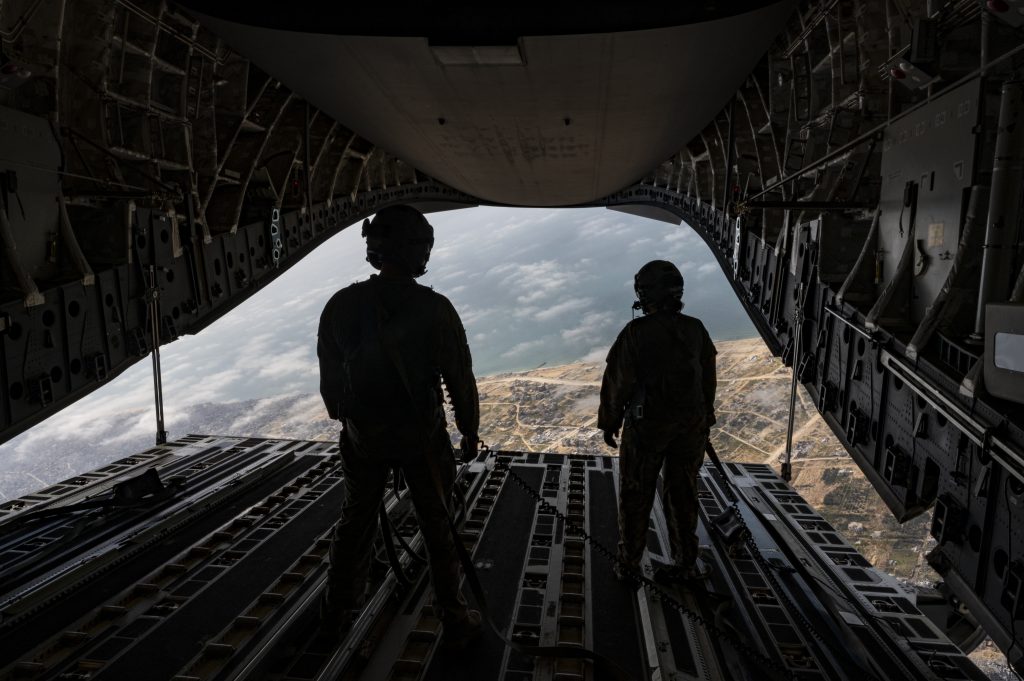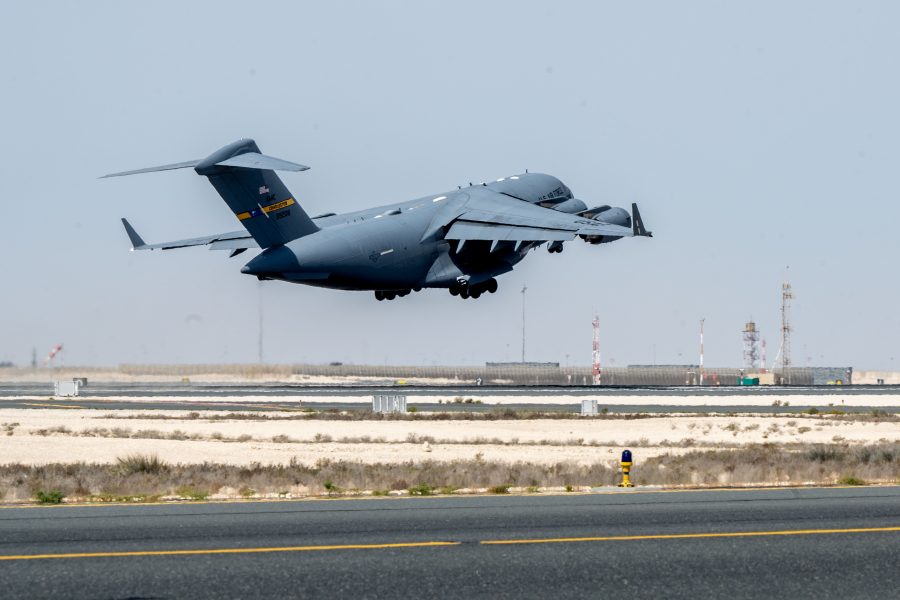The U.S. Air Force has begun using large, quad-jet C-17s to airdrop aid into Gaza, as the U.S. leaders express increasing concern about the humanitarian situation there.
On March 17, two U.S. Air Force C-17s dropped over 28,800 meals and 34,500 bottles of water over northern Gaza—first two-ship USAF C-17 aid airdrop over the enclave, U.S. Central Command (CENTCOM) said. A U.S. C-17 also conducted an airdrop with C-130s on March 13 and March 15, as the U.S. has bolstered its airlift presence in the region assigned to Air Forces Central (AFCENT). The U.S. has conducted nearly daily airdrops, and 13 since the U.S. began aid airdrops into Gaza on March 2, according to CENTCOM.
In recent weeks, the Biden administration and international groups have pressed to do more about the humanitarian situation in Gaza, which is governed by Hamas and has been besieged and bombed by Israel during its war with the military group after its Oct. 7 attack on Israel. Hundreds of thousands of people in Gaza are at risk of famine, United Nations officials have warned.
The U.S. is going to increasingly significant lengths to get food and other humanitarian aid into Gaza. Recently, a flotilla of U.S. Army ships left port in Virginia, where they will cross the Atlantic and build a complex, makeshift port off the coast of Gaza. Some 1,000 U.S. troops will construct a floating pier and a roughly 1,800-foot-long causeway attached to the shore—called Joint Logistics Over-the-Shore (JLOTS). Vessels and barges will transport the aid from the pier to the causeway. From the causeway, vehicles will then deliver the aid into Gaza. But that process won’t happen for roughly 60 days, the Pentagon said last week.
In the meantime, the U.S. is conducting airdrops and pushing Israel to allow more land corridors of aid into Gaza by truck. C-130s can carry roughly a truckload of aid, while C-17s have a much larger cargo capacity.

The Air Force C-17s arrived in AFCENT from Joint Base Charleston in recent days, but a U.S. official declined to specify how many C-17s are now in the Middle East or if more are planning to arrive. However, the official said the number of crews qualified to conduct airdrops has increased. Some C-17s were already present in the region, and the U.S. has not disclosed where the C-17 missions over Gaza have originated. U.S. C-130s have been taking off from Jordan, which first began the airdrop effort.
“They’re great partners,” Air Forces Central Commander Lt. Gen. Alexus G. Grynkewich said as Air & Space Forces Magazine accompanied him across the region in early February, before the airdrops began. “With all the tension in the region, being able to have frank and honest conversations about the way forward and how we’re going to work together in areas where we can collaborate is always valued.”
Since AFCENT started conducting airdrops over Gaza, it has conducted some joint sorties with the Royal Jordanian Air Force, including during the first U.S. mission. AFCENT and Jordan carried out their latest joint mission on March 16.
A growing coalition of countries are conducting airdrops, but many aid groups say the drops are insufficient to feed the hundreds of thousands of people in need. In addition to the limited amound of aid aircraft can carry, airdrops can also be dangerous for those on the ground. A C-17 that appeared to belong to the United Arab Emirates airdropped aid that reportedly killed five people when a parachute failed to deploy last week. CENTCOM said the U.S. was not involved in the incident.
The U.S. says increasing land aid routes is the best option, which Israel has resisted.
“That’s something that we continue to pressure,” deputy Pentagon press secretary Sabrina Singh said on March 14. “We continue to want to see humanitarian aid increase into Gaza. The best way to do that is by land options. Those are clearly, you know, not viable at this time.”
For now, airdrops will have to do, the Pentagon says.
“As you are seeing, this department is working around the clock to also provide humanitarian aid to Palestinians in Gaza, whether that be through airdrops … and then, of course, the floating pier that we will be setting up that will be off the coast of Gaza, that will be able to get whether it be—meals, water, whatever else the people need—be able to flow that into Gaza at a more regular rate,” Singh added.
Editor’s Note: This article was updated on March 17 after additional airdrops.

